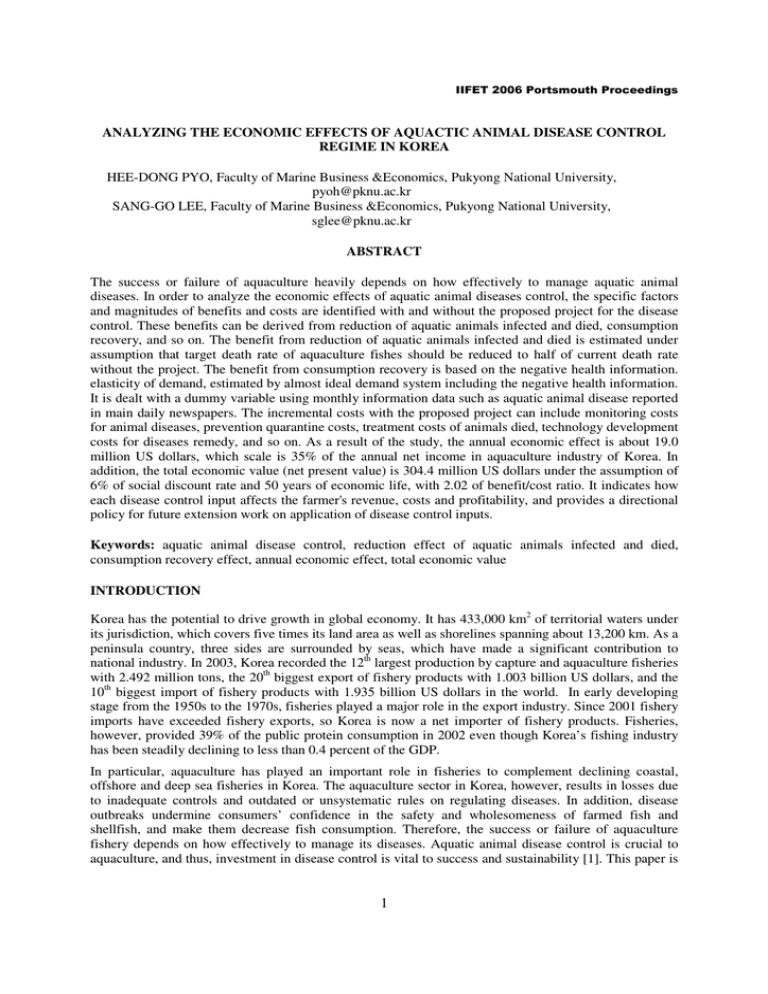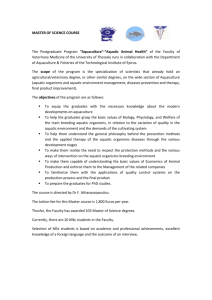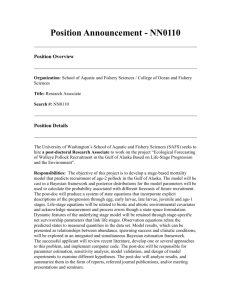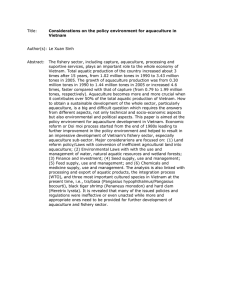ANALYZING THE ECONOMIC EFFECTS OF AQUACTIC ANIMAL DISEASE CONTROL
advertisement

ANALYZING THE ECONOMIC EFFECTS OF AQUACTIC ANIMAL DISEASE CONTROL
REGIME IN KOREA
HEE-DONG PYO, Faculty of Marine Business &Economics, Pukyong National University,
pyoh@pknu.ac.kr
SANG-GO LEE, Faculty of Marine Business &Economics, Pukyong National University,
sglee@pknu.ac.kr
ABSTRACT
The success or failure of aquaculture heavily depends on how effectively to manage aquatic animal
diseases. In order to analyze the economic effects of aquatic animal diseases control, the specific factors
and magnitudes of benefits and costs are identified with and without the proposed project for the disease
control. These benefits can be derived from reduction of aquatic animals infected and died, consumption
recovery, and so on. The benefit from reduction of aquatic animals infected and died is estimated under
assumption that target death rate of aquaculture fishes should be reduced to half of current death rate
without the project. The benefit from consumption recovery is based on the negative health information.
elasticity of demand, estimated by almost ideal demand system including the negative health information.
It is dealt with a dummy variable using monthly information data such as aquatic animal disease reported
in main daily newspapers. The incremental costs with the proposed project can include monitoring costs
for animal diseases, prevention quarantine costs, treatment costs of animals died, technology development
costs for diseases remedy, and so on. As a result of the study, the annual economic effect is about 19.0
million US dollars, which scale is 35% of the annual net income in aquaculture industry of Korea. In
addition, the total economic value (net present value) is 304.4 million US dollars under the assumption of
6% of social discount rate and 50 years of economic life, with 2.02 of benefit/cost ratio. It indicates how
each disease control input affects the farmer's revenue, costs and profitability, and provides a directional
policy for future extension work on application of disease control inputs.
Keywords: aquatic animal disease control, reduction effect of aquatic animals infected and died,
consumption recovery effect, annual economic effect, total economic value
INTRODUCTION
Korea has the potential to drive growth in global economy. It has 433,000 km2 of territorial waters under
its jurisdiction, which covers five times its land area as well as shorelines spanning about 13,200 km. As a
peninsula country, three sides are surrounded by seas, which have made a significant contribution to
national industry. In 2003, Korea recorded the 12th largest production by capture and aquaculture fisheries
with 2.492 million tons, the 20th biggest export of fishery products with 1.003 billion US dollars, and the
10th biggest import of fishery products with 1.935 billion US dollars in the world. In early developing
stage from the 1950s to the 1970s, fisheries played a major role in the export industry. Since 2001 fishery
imports have exceeded fishery exports, so Korea is now a net importer of fishery products. Fisheries,
however, provided 39% of the public protein consumption in 2002 even though Korea’s fishing industry
has been steadily declining to less than 0.4 percent of the GDP.
In particular, aquaculture has played an important role in fisheries to complement declining coastal,
offshore and deep sea fisheries in Korea. The aquaculture sector in Korea, however, results in losses due
to inadequate controls and outdated or unsystematic rules on regulating diseases. In addition, disease
outbreaks undermine consumers’ confidence in the safety and wholesomeness of farmed fish and
shellfish, and make them decrease fish consumption. Therefore, the success or failure of aquaculture
fishery depends on how effectively to manage its diseases. Aquatic animal disease control is crucial to
aquaculture, and thus, investment in disease control is vital to success and sustainability [1]. This paper is
1
to identify and estimate the economic effects of disease control programs with understandings of status of
Korean fisheries and aquaculture disease outbreaks.
STATUS OF FISHERIES IN KOREA
From 1985 annual total fishery production in Korea reached more than 3 million tons, but since 1996 it
has been decreasing, as shown in Table I and Figure 1. That results from restrictions of fishing activities
caused by the declaration of United Nation on the Law of the Sea (UNCLOS) and a serious degradation
of fishery environment. Aquaculture production in 2003 amounted to 826,245 tons, which is 33.2 % of
total fishery production of 2,486,617 tons. In particular, the policy “Development in nurturing fishery”
has led to aquaculture being given much weight in fisheries. In the coastal and offshore fisheries the main
target species are anchovy, squid, hair tail and horse mackerel, while in the deep-sea, squid, skipjack, and
Alaska Pollack, in the aquaculture, fish species (flatfish and black rockfish), shell fishes (oyster, short
neck clam and sea mussel), and seaweeds (laver and sea mustard).
The number of fishermen including the crews of deep-sea fishing vessels having been decreasing sharply
– 320,000 in the 1970s, 260,000 in the 1980s, 140,000 in 2000, 130,000 in 2002 – and the trend is
expected to continue [2]. That is due to the development of advanced fishing gear and methods,
improvement of fishing vessels and reduction of fishery resources.
Table I: Trend of Fishery Production in Korea
Year
Total production
Coastal/Offshore
Aquaculture
Distant Waters
Inland Waters
From KMI (2005).
1985
3,102
1,495
788
767
53
1990
3,275
1,472
773
919
34
1995
3,348
1,425
996
897
29
2000
2,514
1,189
653
651
21
2001
2,665
1,252
656
739
18
?A@,B C$DFE,G @,H$I!JB K @$L
M @,C,NFB C$D O PRQ Q N"S!@$G T
UV$I!C,J!I,D B I,G T
WK NB C$LB"XYC,B T$G N
Z L,D C$L!HXYC,B T$G N
>
9
7 <3
4 <9
=
;7 5<3
:9
87 3
4 56
1 23
' !"
%& !"
#$ !"
!"
)("*'
)("*"+
)("*"*
)("("
)("(!#
) ("('
-./0
)("("+
Figure 1. Trend of Fishery Production in Korea
2
(Unit: 1,000 tons)
2002
2003
2,476
2,487
1,096
1,097
782
826
580
544
19
20
)("("*
#,""
#""!#
#,!'
STATUS OF AQUATIC ANIMAL DISEASE IN KOREA
Aquatic animal disease problems are serious in many areas where more intensive farms have been
operating. Diseases are commonly caused by bacteria, protozoa, viruses, fungi and toxins. Bacterial,
protozoan and viral infections are among the most common diseases encountered in fish aquaculture
(Table II). Of main aquatic fish species, flatfish in Table III and Figure 2, was infected by bacteria
(61.4%), protozoa (36.8%), and viruses (1.8%), while black rockfishes by bacteria (49%), protozoa
(37%), viruses (2%), and others (12%), in 2002.
Table II: Status of Aquatic Animal Disease Outbreaks
Rate of Disease Outbreaks (%)
1996
1997
1998
Bacteria
72.4
48.5
45.3
Protozoa
21.9
28.8
22.5
Viruses
4.6
7.8
7.8
Bacteria-mixed
1.0
10.5
8.2
Bacteria+protozoa 0.1
2.0
5.8
From MOMAF (Ministry of Maritime Affairs and Fisheries)’s internal data
Types of Disease
1999
46.5
23.8
12.8
9.0
7.9
Table III: The Rate of Diseases Outbreaks for Flatfishes
Types
of The rate of diseases outbreaks for flatfishes (%)
Disease
1996
1997
1998
1999
2000
2001
Bacteria
72.0
66.4
61.8
61.8
60.5
69.6
Protozoa
24.0
18.5
19.4
19.2
29.4
26.1
Viruses
0
8.1
12.4
10.7
6.9
3.7
Others
4
7
6.4
8.3
3.2
0.6
From MOMAF’s internal data
[\]Y^ _` ]bac_Ade_`gf h.if j$]A_kj&]bae&`glA^ ]A_m!jnc a^Acgo _` cgf jk\]kj
.
Y R
uApq p
2002
61.4
36.8
1.8
0
tApq p
}
~}
}~|
z{ |
s pq p
rpq p
pq p
v"wAw t
v"wAwkx
v!wAw u
v"wAwAw
rpkpAp
rApAp v
rpApr
y]k_^
Figure 2. The Rate of Aquatic Diseases Outbreaks for Flatfishes
As shown in Table IV, annual death rate of aquatic animals has been steadily decreasing, representing
about 10% in case of fish species and 52% in case of prawn, for average death rate from 2001 to 2005.
According to Table V, the death rate of flatfishes in total aquatic animals is highest at 13.1%, next one is
yellow tail (10.4%) and so on.
3
Years
Fish Species
Prawn
Fish Species
Flatfish
Black rockfish
Sea bass
Sea bream
Mullets
Others
Total
Table IV: Trends of Aquatic Animal Death Rate (unit: %)
2001
2002
2003
2004
13.5
11.9
8.4
7.8
68.7
64.9
53.5
32.4
Table V: Status of Aquatic Animal Death in 2005
No. of Cultivation (thousand) No. of Death (thousand)
182,511
23,932
368,687
14,599
19,632
1,026
107,477
11,202
39,977
350
29,068
1,703
747,352
52,812
2005
7.1
40.3
Rate of Death (%)
13.1
4.0
5.2
10.4
0.9
5.9
7.1
THE EECONOMIC EFFECTS OF AQUATIC ANIMAL DISEASE MANAGEMENT
The structure of a benefit-cost analysis
One of economic tools for comparing the desirable and undesirable impacts of proposed policies is
benefit-cost analysis (BCA). BCA systematically identifies and organizes economic cash inflows and
outflow that are expected to result from a proposed public policy or program. Much confusion, however,
surrounds this analysis in practice versus in principle. There is no doubt that BCA has been misused and
abused. Therefore, only its appropriate usage can revive its merits. Cash flows can be formally expressed
as incremental definition: Incremental cash flows = cash flows with the project – cash flows without the
project. It is important not to fall in to the trap of thinking that a direct comparison of before and after
project scenarios is equivalent to incremental cash flows.1
There are several capital budgeting models which represent discounting techniques: net present value
(NPV); internal rate of return (IRR); and benefit/cost ratio (B/C ratio). NPV takes net incremental cash
flows and discounts them at the social rate of discount:
NPV =
t =n
t =1
NBt
− I0
(1 + r ) t
where NBt is the net incremental cash flow in year t; r is the opportunity cost of capital, and I 0 is the
initial investment. The decision criterion is that the project should be rejected if NPV<0, otherwise it
should be accepted. On the other hand, the IRR is the rate of discount that lets NPV=0:
0 = −I 0 +
t =n
t =1
NBt
(1 + IRR) t
Projects are selected if the IRR is greater than the opportunity cost of capital. Another way to calculate
the economic decision criteria is B/C ratio by taking the present value of the benefit stream and dividing
by the present worth of the cost stream.
t =n
t =1
t =n
TBt
TCt
/(
+ I0 )
t
(1 + r ) t =1 (1 + IRR) t
If the ratio is greater than 1 then the project should be undertaken.
Identification of benefits and costs
4
The basis for the establishment of economic benefits and costs is the “with and without” principle.
Measuring the economic benefits and costs resulting from aquatic animal disease control programs is not
easy. With the project total revenues increase due to reduction in death, reduction in consumption
substitution effect, and reduction in infection, involving the economic welfare on the part of both
consumer and producer surplus, and disease control costs such as monitoring cost, prevention cost,
treatment cost and R&D cost are also added to the economic costs. Figure 3 stands for an overall
framework of BCA for aquatic animal disease control project.
¦¨§©kª « §¬"­®$¯°k±$«²´³¯k±¬
µ·¶Y¸
¹º·º
¼±A½&¾ª «gª ¿kª « ÀnÁ½$§¬ À&¾ª ¾
¶ ³&« ±½,«gª §A¬)ÁR¾,¾,±¾"¾Â´±A½,«
¼Rª Âîk¬ §$«gª ³½b².³k¯k±¬
­» ¦ º §$«gª ³
­±½$±$Ägª « » Å,³$¾"«kÁ¨½$§¬ À&¾ª ¾
Ê ª ½$§½$Å$ª §¬)Á½$§¬ À&¾ª ¾
É Å,³½$³AÂê ÅÁ½$§¬ À,¾ª ¾
Ï , ¤&ÐF¢ Î) &"¡F
¤!
ÒbÓ£ÔÌÓRÕFÖ ×ÃØÚÙ0×Ö ÛÝܨ×)Ö Þ.Ô
!&! &¡
¡£¢!¤! ¥
!&! &¡£ ¡ !&! &¡ ¡
Ï"öÎ) F &¡
ü ¡FÍ " &¡
÷ùøûúú
õô F õô "& &¡
Ë ¥ & Ì "Í Ë "Î)" !Í&ˤ&Ñ, ¤$Ð
¢ ÎF &"¡F$¤"
¹ ½$¯Aª ß ±kÅ!« É Ä Ä ±kÅ!« ¾kà Éá « ±ßg½&§¬ ª « À
ä£å æ çèêéëkì íRîï íð ñ)òæ
Reduction in economic
loss
¢!¤! ¥
ô ¤!
ü ¡FÍ " &¡
ô ¤!
Æ£³k§¬¼±k±kÇ,ª ½&°È².³¯k±¬
ý ¥!,ô Î
â ÞÙ×ÚØÚÙ×Ö ÛãÜÌ×Ö ÞnÔ
ó "& &¡¤$ÐË "Î) Î
¢ Î!¤"ÎË &¡F ô &Ð
&¡, &ô ¡ÿ õ ô !,¡F &¡ ô !¤! Ì,¡F
þ ) "Î)
) "Î)
) "Î)
Ë &¡Î!,ô
õô Í ,ô ,¡F Ð ¤"Î) ¢
) "ÎF
ý ¥!,ô
Ë "ÎF ô ,Ð ¤" !"¤,) &ô Î
Figure 3. An overall framework of BCA for aquatic animal disease control project
The economic benefits determination
The economic benefits occurred from introducing the new aquaculture disease control regime2 can be
largely classified into the reduction effect of death rate and infection rate and the consumption recovery
effect. The death and infection rate due to disease shifts the supply curve from S to S’ in Figure 4,
5
indicating a change of a sort of technology and factor price which is the non-price variable in the product
supply function. If the death and infection rate can be reduced by the new disease control regime, the
quantity supplied would recover from Q1 to Q0. Meanwhile, aquaculture disease makes consumers
substitute their fish consumption for other product consumption such as beef, shifting the demand curve
from D to D’ in Figure 4.3 In the same way, if the death and infection rate can be reduced, the quantity
demanded would recover from Q2 to Q1.
Figure 4. The recovery effects of social welfare from the new schemes
Likewise, the shaded area in Figure 4 represents the recovery effects of social welfare occurred from the
new aquaculture disease control schemes and can be derived from the following equation.
The estimation of the production recovered
It is not simple to estimate the supply quantity (Q1Q0) and the demand quantity (Q2Q1) recovered
from the reduction of the death and infection rate. Q0 indicates the desirable target quantity
recovered from the reduction of the death rate with the project of the new disease control
scheme, while Q2 is the current quantity produced without the project which reflects current
death rate and consumption substitute rate, and Q1 represents the quantity produced after
outbreaks of aquaculture diseases. Hereafter ‘d’ is the target death rate to reach with the project,
and ‘c’ is the consumption recovery rate. The quantities recovered from the reduction of the
death rate can be calculated as the following equations:
6
It is noted that ‘d’ is an exogenous variable derived from pathological analysis4, while ‘c’ can be derived
from the impacts of negative health information on the raw fish demand. Using the Almost Ideal Demand
System [3] including negative health information [4, 5, 6], this study derived the negative health
information elasticity of demand.5 The negative health information is dealt with a dummy variable which
indicates whether or not aquatic animal disease outbreak was reported in main daily newspapers.6 The
results of the negative health information elasticity of demands for flatfish, black rockfish, yellow tail, sea
bass, sea bream and beef are -0.2681, -0.0823, -0.0392, -0.0618, -0.0391 and 0.004307, respectively. It is
confirmed that the negative health information variable negatively affects the raw fish consumption and
positively affects the beef consumption, showing the theoretical validity. For example, a 1 % decrease in
the death rate for flatfish results in 0.268 % increase in the quantity demanded which means the
consumption recovery rate (c).7 The estimation of the quantities recovered from the death and infection
rate is specifically shown in Table VI.
Table VI: The estimation of the quantities recovered from the death and infection rate
(Unit: M/T)
Flatfish Black rockfish Yellow tail Sea bass Sea bream Other fishes Crustaceans Shellfish Others
d 5%
5%
5%
5%
5%
5%
20%
5%
5%
c 1.341%
0.412%
0.196% 0.309% 0.196%
0.877%
5.362%
1.341% 1.341%
Q2 32,141
19,708
45
1,850
6,833
3,899
2,426
304,889 9,176
Q1 32,578
19,790
45
1,856
6,846
3,933
2,526
309,049 9,301
Q0 34,292
20,918
47
1,953
7,207
4,141
3,204
325,298 9,790
Note. 1. Consumption recovery rate of other fishes is assumed from the weighted average consumption
recovery rate of flatfish, black rockfish, yellow tail, sea bass and sea bream.
2. The negative health information elasticity of crustaceans, shellfish and others are assumed to
be equal to that of flatfish
The estimation of variable costs
Holding marginal costs constant assumption in the study, average variable costs can be substituted for the
marginal costs. The data for variable costs standardized by sampling survey include seed cost, fuel cost,
feed cost, medicine cost and others. As shown in Table VII and Table VIII, the weighted average variable
costs per ton are calculated into 3,983 dollars and 3,535 dollars, for flat fish and black rockfish
respectively.8
The estimation of incremental cost for the project
The cost of disease control project includes monitoring costs for animal diseases, prevention quarantine
costs, treatment costs of animals died, technology development costs for diseases remedy, and so on. This
paper introduces disease control cost estimated from MOMAF for benefit-cost analysis, which scale is
totally 19,018 thousand US dollars.
7
Table VII: The estimation of standard variable cost for flatfish
Size(ha)
Quantity(tons)
Seed cost
Fuel cost
Feed cost
Medicine cost
Others
Total variable cost
Variable cost/ton
0.2
44
55700
8524
75805
19780
15981
175790
3995.2
0.33
52.4
57944
9347
96075
26018
18938
208322
3975.6
0.46
92.2
71572
19869
199222
45151
33581
369395
4006.5
0.46
118.3
106650
4443
271202
43931
42623
468849
3963.2
(Unit: $1)
Average
306.9
291866
42183
642304
134880
111123
1222356
3982.9
Table VIII: The estimation of standard variable cost for rockfish
Size(ha)
Quantity(tons)
Seed cost
Fuel cost
Feed cost
Medicine cost
Others
Total variable
costs
Variable
cost/ton
0.2
25.5
17500
1000
71600
6000
9610
0.25
19.6
11366
2040
29300
2208
4491
0.4
26.6
17000
4800
82040
10500
11434
0.5
42.26
31110
6000
117810
8760
16368
0.7
43.8
21000
7200
98554
6480
13323
1
128.5
80000
12240
284800
24480
40152
1.5
125.05
88000
7440
263074
9600
36811
(Unit: $1)
Average
411.3
265976
40720
947178
68028
132190
105710
49405
125774
180048
146557
441672
404925
1454092
4146
2521
4728
4261
3346
3437
3238
3535
Results of the economic effects
Due to the restriction of data, this paper attempts to analyse a simplified preliminary feasibility in Table
IX. As shown in Table IX, if the death rates with the project are changed into half of the average death
rate without the project, the annual economic effect and the total economic value (net present value) of
the new aquatic animal disease control system is estimated as 19,315 thousand dollars and 304,444
thousand dollars in which benefit/cost ratio is 2.016 under 6% of social discount rate and 50 years of the
economic life for the project, respectively.9 The estimated annual economic effects account for 35% of
annual net profits under the assumption of the rate of return of 10% which is relatively considerable.
8
Table IX: Results of benefit-cost analysis for the economic effectiveness
(Unit: thousand dollars, MT)
Items
Flatfish
Rockfish
Market price/ton
9.430
8.262
Variable cost/ton
3.983
3.535
Quantity (with project)
34,292
20,918
Q0
Quantity (without
32,141
19,790
project) Q2
Death rate (with
0.05
0.05
project)
Consumption recovery
0.01341 0.00412
rate
Total revenues
303,090 163,505
Incremental benefits
11,717
5,330
Incremental costs
Annual economic effect
Total economic value (NPV)
b/c ratio
Other
fishes
10.612
4.541
16.308
8.154
0.951
0. 476
Other aquatic
animals
1.949
0. 975
14,624
3,204
325,298
9,790
13,860
2,426
304,889
9,176
0.05
0.20
0.05
0.05
0.00234
0.05362
0.01341
0.01341
147,082
4,636
39,563
6,346
289,949
9,704
17,884,
599
Crustacean Shellfish
Total
961,074
38,333
19,018
19,315
304,444
2.016
CONCLUSION
Aquaculture fishery in Korea has led other declining fisheries such as coastal, offshore, deep sea, and
inland fisheries. Therefore, an effective aquatic animal disease control is critical to sustain the fisheries in
Korea. Firstly, the paper reviewed status of fisheries and aquatic animal disease in Korea. Aquaculture
production in 2003 accounts for 826,245 tons, which is 33.2% of total fishery production. Flatfish
production forms about 60%, and black rockfish production, about 30%, in fish aquaculture. The death
rate of flatfishes in total aquatic animals is the highest at 13.1%, that of black rockfish, 4.0%. Secondly,
the paper analysed the annual economic effects and the total economic value (net present value under the
assumption of 6% of social discount rate and 50 years of the economic life) of aquatic animal disease
control programs. Under the limited data the annual economic effect and the total economic value were
estimated as 19,315 thousand dollars and 304,444 thousand dollars, in which benefit/cost ratio is 2.016,
respectively. The estimated annual economic effects account for 35% of annual net profits under the
assumption of the rate of return of 10% which is relatively considerable.
It indicates how each disease control input affects the farmer's revenue, costs and profitability, and
provides a directional policy for future extension work on application of disease control inputs. A more
refined method, however, needs to be introduced for determining optimal investment in aquatic animal
disease control.
REFERENCES
[1] Israngkura, A. and S. Sae-Hae, 2002, A review of the economic impact of aquaculture animal disease.
9
pp. 253-286. In: J.R. Arthur, M.J. Phillips, R.P. Subasinghe, M.B. Reantaso and I.H. MacRae.
(eds.) Primary Aquatic Animal Health Care in Rural, Small Scale, Aquaculture Development,
FAO Fish. Tech. Pap. No. 406.
[2] Korea Maritime Institute, 2004, Fisheries, marine environment statistics. KMI.
[3] Deaton, A. and J. Muellbauer. 1980. An Almost Ideal Demand System. American Economic Review,
70, pp. 312-326.
[4] Chang H.S. and H.W. Kinnucan, 1991, Advertising, Information and Product Quality : The Case of
Butter. American J. of Agricultural Economics, 73, pp. 1195-1203.
[5] Chern, W.S., T.L. Edna and T.Y. Steven, 1995, Information, Health Risk Beliefs, and the Demand for
Fats and Oils. Review of Statistics and Economics, 77, pp. 555-564.
[6] Brown, D.J. and L.F. Schrader, 1990, Cholesterol Information and Shell Egg Consumption. American
J. of Agricultural Economics, 72, pp. 548-555.
ENDNOTES
1
Consider the following example. An investment project has been proposed to increase the productivity
of flatfish farms by controlling its diseases. Without the project it has been estimated that the flatfish
stock will grow at approximately 1.3%. With the project its stock is estimated to increase by 3.4%.
Correspondingly its production is expected to increase over the economic life of the project at a
similar rate. If the project analyst compared the output before and after the project he would
erroneously attributed the total increase in its production, approximately 3.4%, to the project
investment. Actually what can be attributed to the project investment is only 2.1% (=3.4%-1.3%)
increase in production since 1.3% would have occurred anyway.
2
The new proposals are aimed at improving the health of fish, crustaceans and mollusks and reducing the
mortality rate due to disease. In contrast with existing legislations, the main emphasis of the new one
will focus on preventing the outbreak of disease rather than dealing with the consequences of an
outbreak. The new scheme will replace several existing directives with just one, offering more
flexibility for decisions to be taken at national, local or farm levels.
3
The shift in demand is due to a change of consumer’s preference rather than a change of its own price.
4
In this paper the target death rates are assumed to reduce to half of average death rate for five years from
2001 to 2005 as shown in Table 4.
5
The negative health information elasticity of demands measures the responsiveness of the quantity
demanded to a change in the negative health information of the product, holding constant the value of
all other variables in the demand function. More detailed explanation is beyond the objective of the
paper.
6
The negative information data used include data from January 1994 to December 2002.
7
c= - (negative information elasticity for each aquatic animals
reduction rate of death rate). For
example, consumption recovery rate for flatfish=0.2681 (10%-5%) = 1.341%
For simplified analysis, variable costs for other aquatic animals excluding flatfish and rockfish are
supposed to be approximately 50 % of their market prices.
9
Annual incremental benefits can be calculated as follows:
8
10



